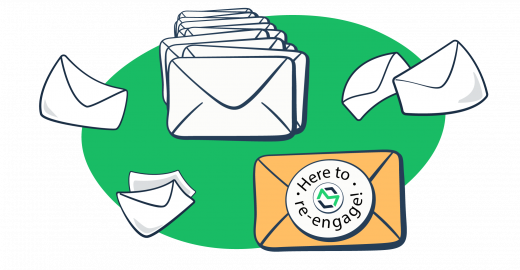In today’s highly dynamic world of email marketing, ensuring positive customer engagement is crucial. But what do you do when subscribers lose interest and become inactive? The answer is simple, launch a re-engagement email campaign. Of course, it’s more complicated than it sounds, so let’s explore actionable steps, effective templates, and vital insights to craft and implement successful re-engagement email campaigns.
What is a re-engagement email?
A re-engagement email is a special type of message within an email marketing campaign aimed at renewing the relationship with inactive subscribers on your email list.
These are individuals who, at some point in time, have shown interest in your brand and chose to opt-in to receive your emails but, over time, for different reasons, stopped engaging. The dwindling engagement rates are reflected in the metrics through a low open rate, click-through rate, etc.
The primary goal of a re-engagement email is to reignite interest, reactivate those subscribers, and retain them, ultimately reducing churn and increasing customer loyalty.
The creation of an effective re-engagement email requires strategic planning and careful crafting. Good emails often start with compelling email subject lines that are designed to spark the curiosity of your unengaged subscribers, encouraging them to open emails from you again.
The content of the email must then be relevant and appealing, providing a strong call to action (CTA) that incentivizes the subscriber to interact, but the subject line is still the key point. The incentive can be new features or products, offering coupons or other discounts, or simply reminding them of why they subscribed in the first place. According to a report done by DontPayFull, 79% of shoppers would give their email address in exchange for a coupon code.
Re-engagement email examples
To better understand re-engagement emails, let’s take a look at a few real examples and analyze their attributes and campaign goals.
🎯“To The Point” approach: Our first example, from Stadium, has a clear, direct approach with no fluff writing. The subject line alerts the recipient about their expiring rewards points and creates a sense of urgency that encourages the reader to return to the platform and make a purchase.
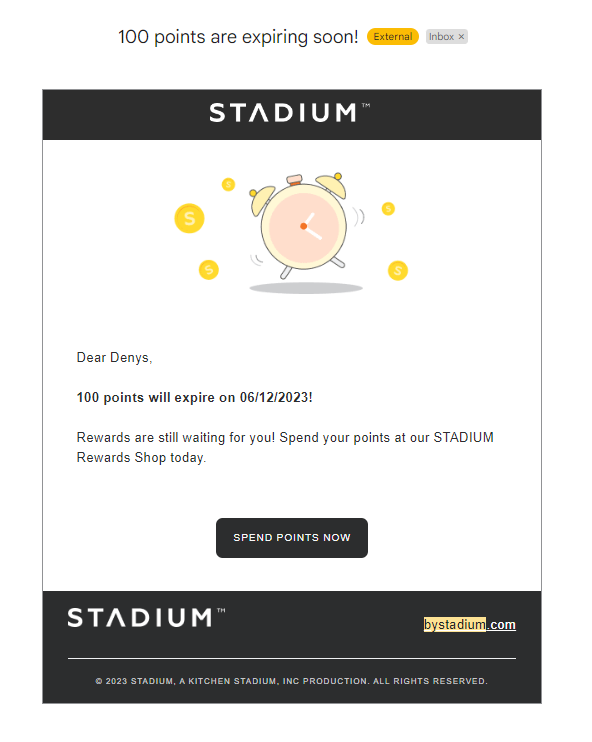
The email’s content slightly expands on the main message but still stays to the point. A simple yet topic-relevant image, a touch of personalization in the greeting, and a straightforward call-to-action.
🔔“The Gentle Reminder” approach: Our second example, from Team Wistia, is a reminder email sent promptly after a webinar to participants who still need to take subsequent action. It uses a subject line that reconnects with the recipient and reminds them about the recent webinar attendance. The email effectively highlights the product’s value before pitching a risk-free trial, merging description and promotion.
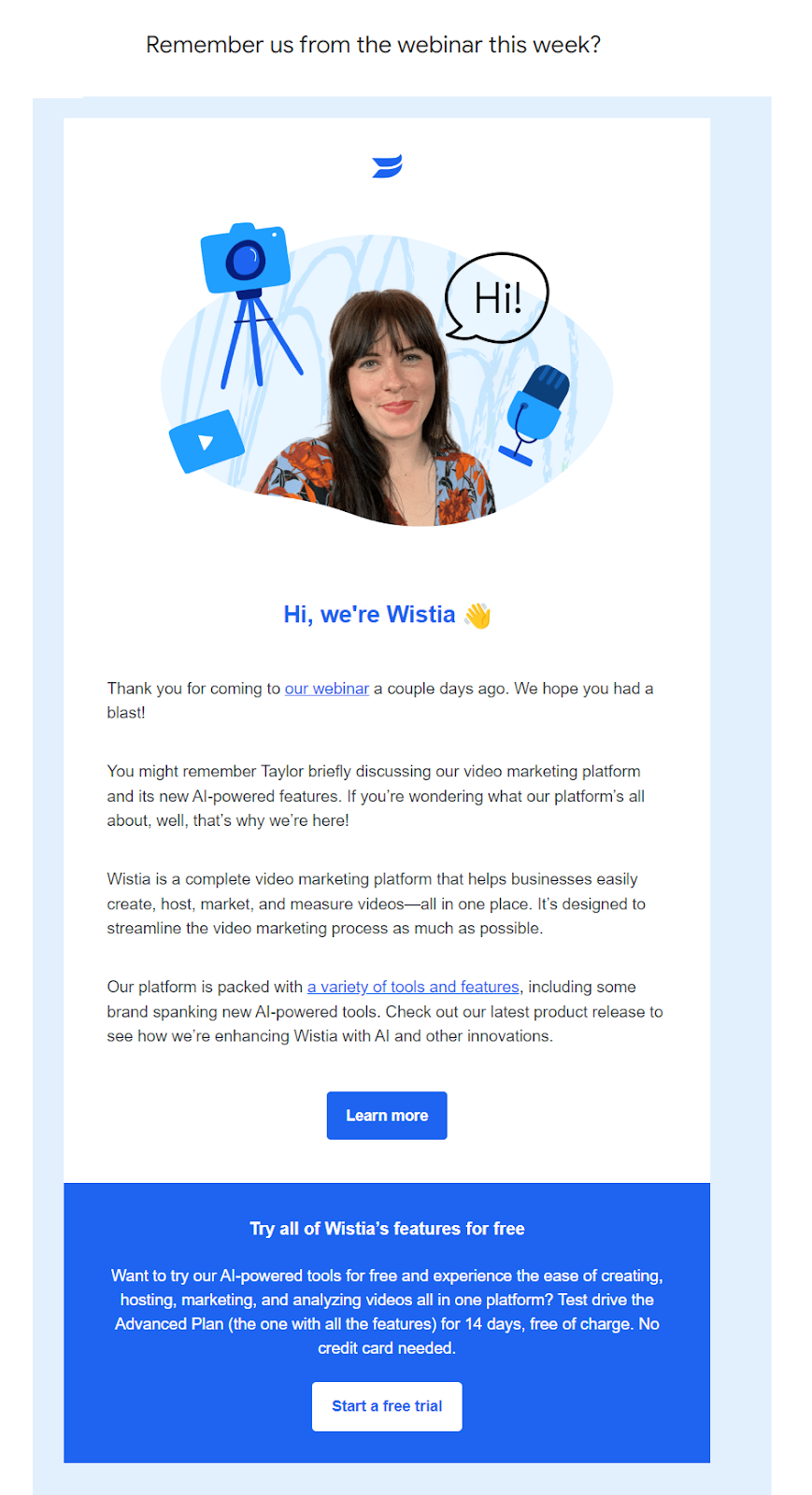
By employing color differentiation to grab attention, the product description is neatly presented on a white background, followed by a bold blue section offering the risk-free trial, each with its distinct call-to-action. This clever use of color and layout not only heightens user interest but also guides their attention toward the primary action points.
❤️ “The Empathetic Motivator” approach: Our third example, from Duolingo, employs a strategy that has an emotional hook and motivation to re-engage users effectively. Sent to a user who’s taken a hiatus from their language lessons, the subject line aims to trigger an emotional response and a sense of personal dedication.
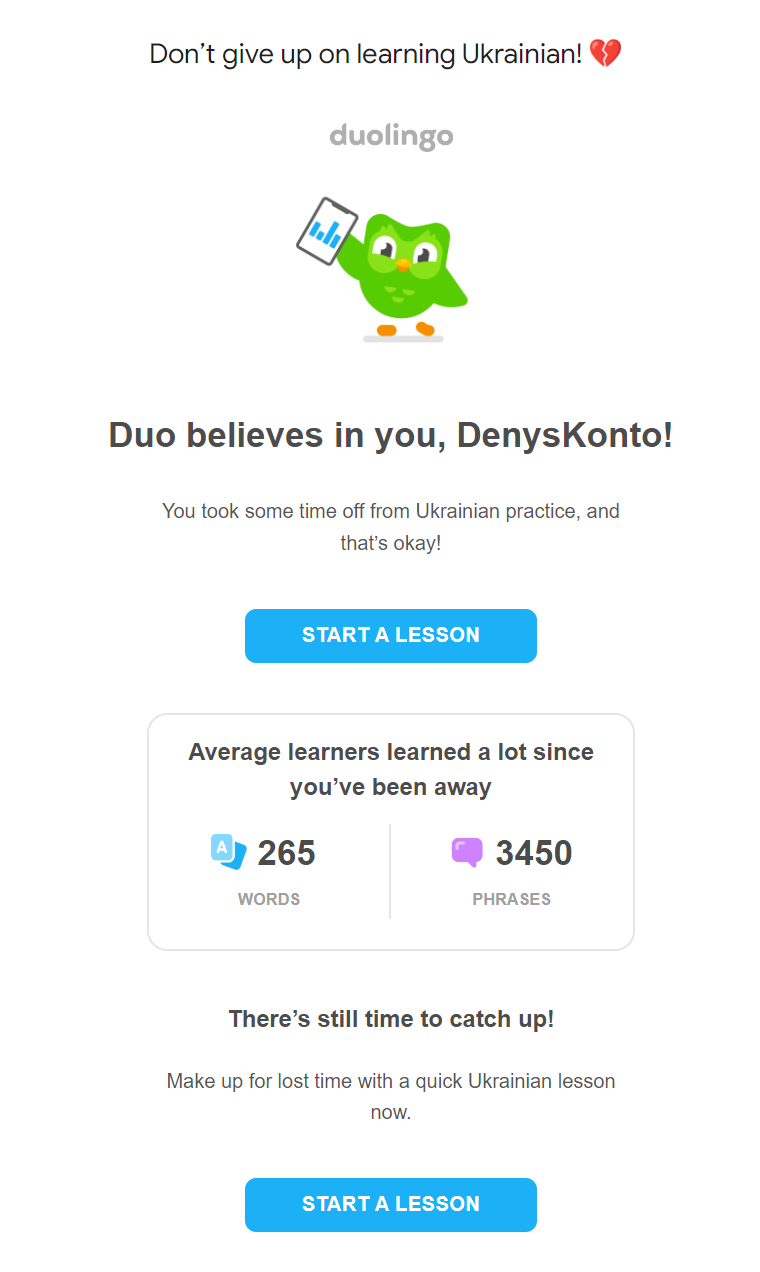
The content acknowledges the recipient’s break in a supportive manner, and then re-engages them with the dual prompts to “Start a Lesson”. The email cleverly uses a healthy competitive edge by highlighting the progress of other learners, adding an extra nudge to resume their language journey.
Why should you launch re-engage email campaigns?
To reactivate inactive customers, drive revenue, and maintain a healthy sender reputation. Re-engaging email campaigns serve several strategic purposes, making them a vital component of your overall email marketing strategy.
Firstly, they help maintain and clean your email list by identifying inactive users who may otherwise negatively impact your email deliverability rate. This is because ISPs and email providers often assess sender reputation based on engagement rates. High levels of unengaged recipients might flag your emails as potentially unwanted, thus impacting your overall deliverability rate.
Secondly, re-engagment email campaigns play a critical role in customer retention. Rather than focusing solely on acquiring new customers, businesses often find it more cost-effective to retain their existing customers. By reactivating inactive customers, your business could re-energize a potentially significant revenue stream. This could be achieved using a win-back email with an enticing offer or showcasing new products.
Lastly, re-engagment email campaigns allow subscribers to self-segment and customize their email preferences. By offering options in your re-engagement email sequence, such as adjusting the frequency of communication or choosing specific types of content, you empower your subscribers to interact with your brand on their terms. These insights can be used to tailor future email marketing efforts, thereby improving their effectiveness. Such efforts can boost open rates, engagement rates, and the overall relevance of your email marketing campaign to your audience, providing you with a competitive edge in the crowded space of social media campaigns and online marketing.
How to run a re-engage email campaign?
Starting a re-engagement email campaign might feel daunting, but breaking down the process into manageable steps can make it more achievable and less overwhelming. Consider it a journey, with each step building upon the last, moving you closer toward your final destination – a more engaged and active email subscriber list. Each step brings a set of tasks that will need attention, adjustment, and continual optimization.
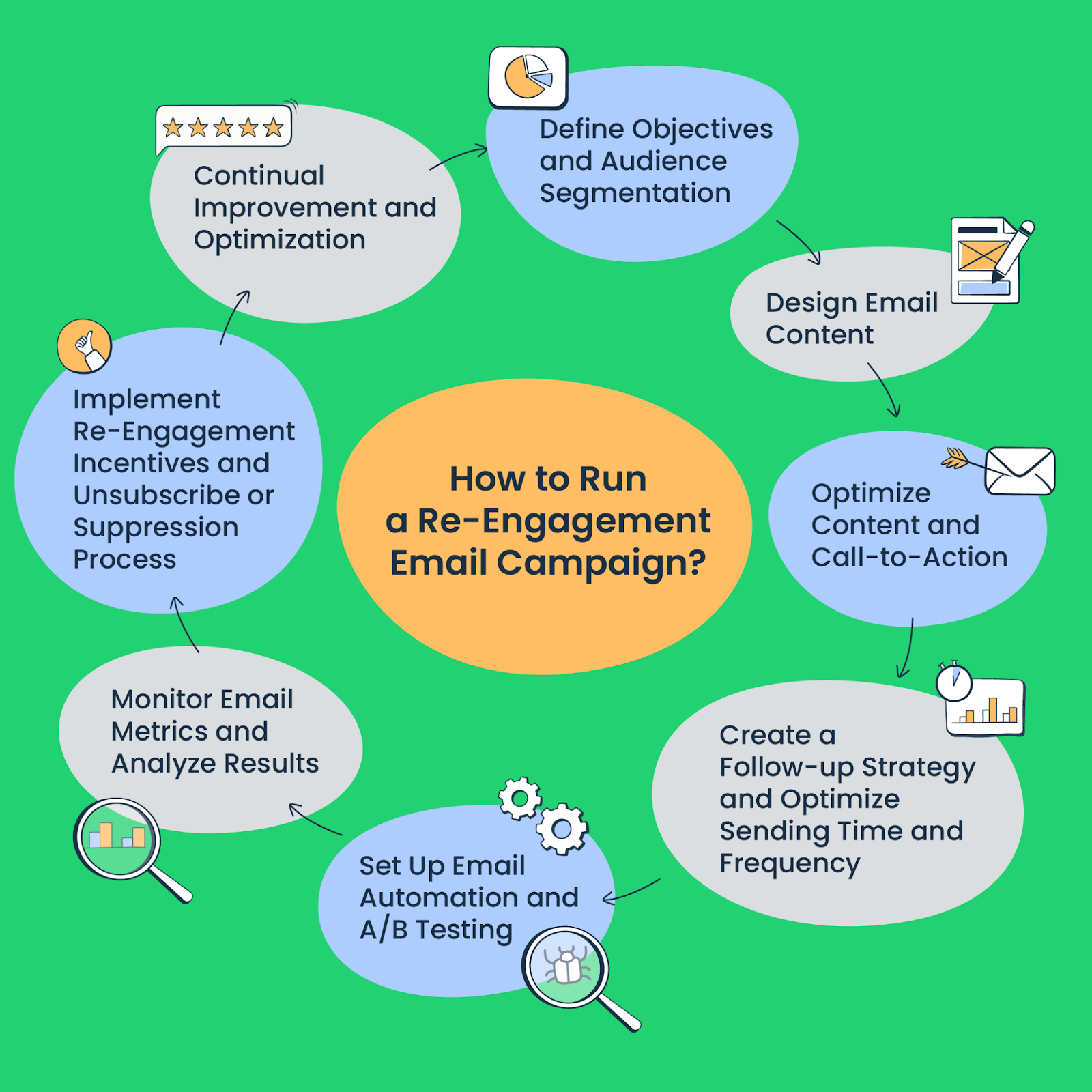
1. Define Objectives and Audience Segmentation: Start by setting clear and achievable goals. Whether it’s to boost open rates, improve click-through rates, or decrease churn – having clear objectives will guide your strategy. Additionally, segment your email list to identify the inactive subscribers you want to target. This could be based on how long they’ve been inactive, their previous engagement rates, or other relevant metrics.
2. Design Email Content: Develop engaging, relevant content for your re-engagement emails. This could include re-engagement email templates, personalized messages, and engaging subject lines. Remember, the key is making inactive users want to re-engage with your brand without coming across as too pushy.
3. Optimize Content and Call-to-Action: Ensure your content is optimized for engagement. Make your call-to-action (CTA) compelling and clear, as this is the element that prompts subscribers to reactivate their interaction with your brand. Consider A/B testing different CTAs to see which generates the highest engagement. If your business uses a VoIP phone service tool that offers a click-to-call feature, include a link in the email allowing users to directly contact your support team, enhancing customer engagement.
4. Create a Follow-up Strategy and Optimize Sending Time and Frequency: Plan out your follow-up emails and optimize them based on when your audience is most likely to be active. This could be a single email or a re-engagement email sequence sent over a period of time. Also, consider the optimal frequency to avoid overwhelming your subscribers.
5. Set Up Email Automation and A/B Testing: Using email automation tools can greatly improve the efficiency and effectiveness of your campaign. It allows you to schedule all types of emails, segment your audience, and perform A/B testing and monitor the results.
6. Monitor Email Metrics and Analyze Results: Keep track of key metrics like open rates, click-through rates, and unsubscribe rates to assess the performance of your re-engagement campaign. Use these insights to refine your approach, content, and segmentation.
7. Implement Re-Engagement Incentives and Unsubscribe or Suppression Process: Offer incentives such as coupons or exclusive content to encourage re-engagement. On the flip side, respect your subscribers’ decision if they choose to remain unengaged. Implement a hassle-free unsubscribe or suppression process for these users.
8. Continual Improvement and Optimization: Remember, this is a continuous process. Based on the results and learnings from each campaign, continually refine and optimize your strategy, content, and processes for improved results in future campaigns.
Re-engage email ideas and templates to use
If you’re seeking effective ways to reconnect with your inactive subscribers, here are five simple re-engagement email concepts and templates for you. They cater to different scenarios and subscriber mindsets. However, bear in mind that they are not “one-size-fits-all” solutions. Adjust and tailor these to fit your brand’s voice and your subscribers’ unique needs, and of course, your brand’s visual design.
Example 1: The Exciting Updates Email
Subject:👋 We've missed you, [Subscriber's Name]! Discover what's new at [Your Brand] 🎉
Hi [Subscriber's Name],
We've noticed that it's been a while since your last visit. You've been missed! There's so much happening here at [Your Brand], and we'd love for you to check it out.
[HTM/CSS Block with what’s new and CTA button]
Explore Now ➡️ [CTA button]
Best,
[Your Name]This lively template breathes fresh air into your engagement approach. By acknowledging their absence and inviting them back enthusiastically, this re-engagement email prompts curiosity and encourages inactive subscribers to check out your new features or products.
Example 2: The Personalized Offer Email
Subject:🎁 Special offer just for you, [Subscriber's Name]!
Hi [Subscriber's Name]!
We've noticed you've been away for a while. To welcome you back, we've created a special offer just for you! Enjoy a special discount on your next purchase.
Use Code: "WELCOMEBACK" 🏷️
Cheers,
[Your Name]This simple personalized template takes advantage of pricing incentives to “lure” back subscribers. By offering a discount exclusive to them, you create a sense of importance and urgency, encouraging re-engagement and potentially reigniting their shopping habits. Too basic? Yes. But people love discounts and it does the job.
Example 3: The Preferences Update Email
Subject:🔍Your opinion matters to us, [Subscriber's Name].
Hey [Subscriber's Name],
We believe in tailoring our content to suit your needs. Help us understand your preferences and make our communication more relevant to you.
Update Email Preferences 📝
Thanks,
[Your Name]This re-engagement email is a strategic way of empowering your subscribers to receive the content they’re interested in. By encouraging them to update their preferences, you improve their engagement rates and create a more personalized experience. Besides, who doesn’t like to give an opinion?
Example 4: The Respectful Unsubscribe Email
Subject:😔Did you forget about us, [Subscriber's Name]?
Hi [Subscriber's Name],
We've noticed you last got active a while ago. We understand that interests change over time. If our emails are no longer relevant to you, feel free to unsubscribe using the link below.
Unsubscribe 📭
Kind Regards,
[Your Name]While it might seem counterintuitive, sometimes it’s necessary to provide a clear and easy way for unengaged subscribers to unsubscribe. This improves your sender reputation and maintains a clean and healthy email list.
Example 5: The Last Chance Win-Back Email
Subject:🙁 Is it goodbye, or can we win you back?
Hi [Subscriber's Name],
Goodbyes are hard. But if you decide it's time to move on, we understand. However, before you go, here's a special offer just for you.
Get 30% Off Your Next Purchase - Use Code "STAY30" 🎈
If you still wish to part ways, you can break our heart and unsubscribe here.
Thank you,
[Your Name]A win-back email like this one presents a final effort to retain the subscriber. It pairs an offer with a respectful, humorous acknowledgment of their potential decision to unsubscribe, balancing persuasion and respect for the subscriber’s choices.
Re-engagement email campaign best practices
A successful re-engagement campaign is both a science and an art, involving a mix of technical know-how, creativity, and an intuitive understanding of your audience. Here’s a list of best practices that can boost the effectiveness of your campaign:
- Utilize Advanced Segmentation – Beyond identifying inactive users, delve deeper into their past behavior and interactions. This might include their buying habits, engagement with previous campaigns, or how they initially opted into your email list. Advanced segmentation can help you personalize your approach and make your re-engagement efforts more targeted and effective.
- Create Dynamic Content – One-size-fits-all content won’t cut it. Your email content should be dynamic, changing based on the user’s behavior or profile. For example, you might send a different reactivation email to a user who has not opened your emails for six months compared to someone who last interacted a year ago. By focusing on these details, you show your personalized approach and thus improve customer satisfaction.
- Use Social Media Insights – If you have a social media presence, use the insights from these platforms to inform your re-engagement campaign. Identify common themes or popular posts that resonate with your audience and incorporate these learnings into your email content. You can use social media analytics report to identify what works for your audience and learn about them, their age, location, and time zones.
- Implement Multi-Touch Campaigns – Don’t rely solely on a single re-engagement email. Instead, use a multi-touch approach that includes a series of emails, scheduling social media posts, and even retargeting ads to re-engage your subscribers.
- Test, Test, and Test Again – Continuous testing is crucial in any re-engagement campaign. Consider using AI-powered platforms that can test multiple variables in real-time, allowing for rapid and accurate optimization of your emails.
- Respect Email Preferences – Always respect your subscribers’ email preferences. If they prefer to receive fewer emails or want to opt-out completely, respect their choices. Not doing so can lead to increased churn and damage your brand reputation.
As we wrap up, it’s important to remember the vital role of efficient email marketing software in making your re-engagement strategies successful. Automating mundane tasks, segmenting audiences, and using handy features like A/B testing and performance analytics is what you want to concentrate on, and good email marketing software is the solution.
The ultimate goal of a re-engagement campaign is to reignite subscriber interest in your brand, which demands continuous effort, understanding of audience needs, and technological proficiency. Remember, by re-engaging inactive subscribers, you reconnect with those who’ve shown interest in your brand and are more likely to convert. So, keep refining, optimizing, and valuing your subscribers!
